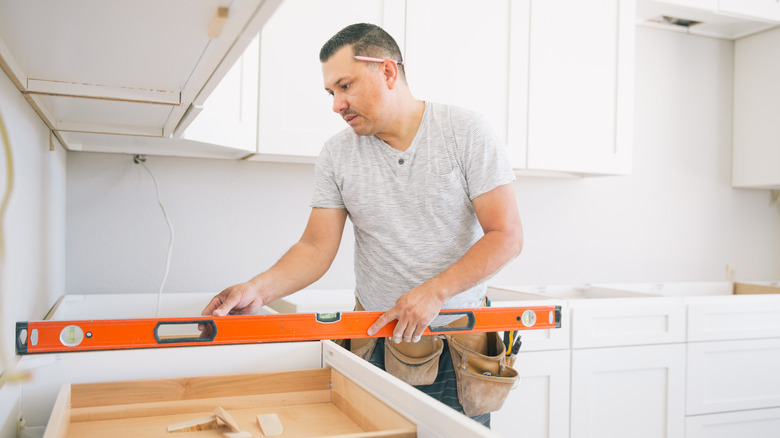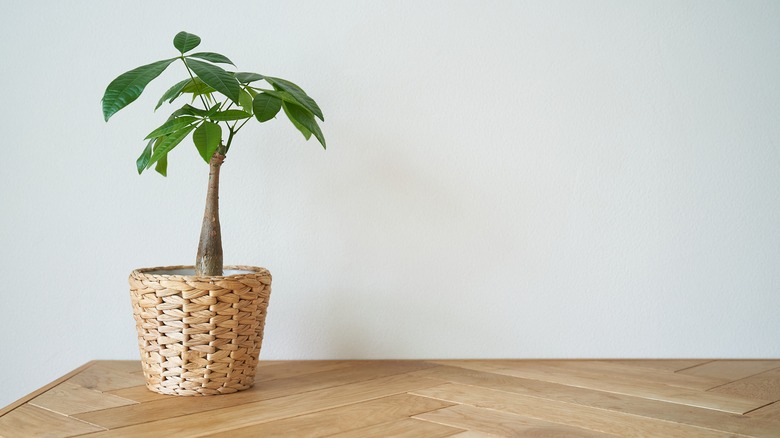Create One-Of-A-Kind Herringbone Countertops With TikTok's Chic Wood DIY
We may receive a commission on purchases made from links.
Genuine wood countertops are having a resurgence of popularity as an alternative to the marble and quartz that have dominated the past decade. Herringbone offers a unique spin on conventional wood or butcher block, evoking an old-world European feel that is also modern at the same time. TikTok user @sydneyleanndesign recently showed off her amazingly budget-friendly DIY herringbone counter created from plywood and 1-by-3-inch pine boards. After using simple wood glue and nails to affix the boards to the plywood, the result is a stunning custom counter that looks much more expensive than it is to create.
According to her Instagram stories, @sydneyleanndesign created a unique wood counter that fits her pantry space perfectly for under $70 in materials. You will need plywood cut to your counter size, several pine 1-by-3 boards, wood putty, stain, and a polyurethane finishing coat to imitate her project. You will also need access to a circular or table saw to cut the wood pieces down to size and finish the edges of the counter.
Creating a herringbone counter
TikTok user @sydneyleanndesign has the plywood cut down to the size needed for her counters at the hardware store, then she purchases a stash of 1-by-3-inch lumber (around $10 each) she plans to cut to size at home. The key to a perfect herringbone pattern is getting the angles and cust right, which @sydneyleanndesign does with a trick she learned from another DIYer. Dividing the counter into three equal segments, she marks them at the end with nails, stringing a piece of thread up and down the length of the board. This thread will be a guide for placing the pattern perfectly, with the center of the herringbone falling along the thread.
Once she has tested placement with some scrap wood to determine the length of the cut pine boards, she begins placing the pieces in a herringbone design. While she initially plans to lay them out before gluing them down, she finds that affixing the first few at the end helps give some structure as she adds additional boards, keeping them in place with wood glue and nails. While the edges initially overhang, she uses a circular saw to trim the edges along the line of the original plywood. To finish the countertop, she adds wood putty to any gaps and nail holes, then sands it down before applying a stain and poly coat to the finished surface.
Customizing the look
This budget-friendly DIY is perfect not only for smaller areas like a pantry but could be used in a larger kitchen space or as an island or tabletop using the same technique. There are also many ways to customize the pattern depending on the look you want, including using smaller or larger pieces of wood. @sydneyleanndesign also blends a bit of paint into her stain as she meticulously applies it by hand with a rag, which provides variation in shading and gives the counter an older, antiqued look.
If you plan to use the counter for food preparation, use a food-safe water-based stain, like Behr's 2-in-1 Stain and Poly from Home Depot, instead of an oil-based one. Another great alternative to a poly coat is a hardwax oil like Rubio Monocoat, which makes the counter especially resistant to scratching and damage. You can also use mineral oil or wood oil instead of traditional stain.
This herringbone counter would fit perfectly in vintage-inspired or traditional kitchens, adding a touch of old Europe that evokes stylish herringbone floors. A lighter stained version would also make a beautifully textured counter in more modern and contemporary style kitchens, offering a far warmer alternative to white marble or quartz.

